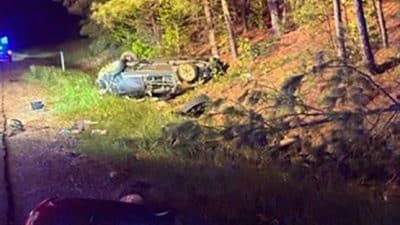
Adult EAB beetles were caught in surveillance traps near Mathews Arm Campground, Gravel Springs Hut, Pinnacles Picnic Area, Big Meadows Picnic Area, and South River Picnic Area. These new finds represent a significant jump from last year’s detections in the northernmost portion of the Park (Warren County) and near Park Headquarters in Page County. They also represent detections in three new Virginia counties including Rappahannock, Rockingham, and Madison.
Park Superintendent Jim Northup stated, “It appears that the emerald ash borer is moving fairly rapidly through the Park from North to South, faster than our staff anticipated. This is a sad reminder of how hard it is to maintain ecological integrity, even in our National Parks.”
The emerald ash borer is a half-inch-long metallic green beetle that lays eggs on the bark of ash trees. After hatching, the EAB larvae burrow under the bark and create feeding tunnels that cut off nutrient and water flow to the tree. As a result, ash trees typically die within three to five years. EAB was accidentally introduced to North America from Asia and was first discovered in southeast Michigan in 2002 on infested wood packaging material. Since its introduction, EAB has spread to 25 states and two Canadian provinces, killing over 50 million ash trees.
Ash trees represent a significant component of Shenandoah National Park’s ecosystems. Five percent of the trees in the Park are ash. This may not sound like a lot; however, ash trees are found throughout the Park and occur in 16 of its 34 vegetation communities. Collectively, these ash-containing communities make up 65% of the Park’s forest (126,883 acres). If EAB becomes well established in Shenandoah, it could lead to upwards of 95% ash mortality.
Since the EAB is a nonnative pest, the Park is mandated to minimize its impacts on native ash trees. In April 2013, staff began conducting preventive EAB pesticide treatments on ash in developed areas and select sensitive plant communities in the northern third of the Park. Every year since, Park staff have conducted treatments in the North District and this year now include portions of the Central District.
The project goals are to reduce hazard ash tree formation in developed areas and to preserve a portion of the Park’s ash trees until approved biological controls become available. Park staff treated 1,030 ash trees in spring 2015. The treatment window for effective EAB suppression in the Park is April and May. Complete eradication of EAB is not currently feasible, but Park managers are taking these actions to maintain public safety and to protect ash trees where possible.
EAB and other exotic forest pests can be transported via firewood. To minimize this pathway of introduction, Park regulations only allow heat-treated firewood (USDA approved) and firewood that is collected within the Park. For more information about firewood regulations at Shenandoah, go online to ww.nps.gov/shen/
More information about emerald ash borer can be found at www.emeraldashborer.










